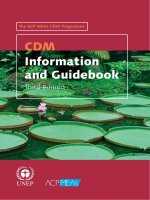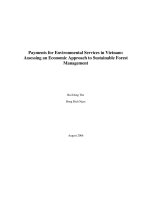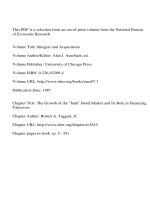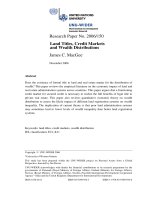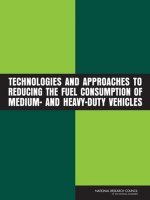Sustainable Land Management (SLM) Technologies and Approaches pot
Bạn đang xem bản rút gọn của tài liệu. Xem và tải ngay bản đầy đủ của tài liệu tại đây (15.39 MB, 321 trang )
Sustainable Land Management (SLM)
Technologies and Approaches
October 2011
Tajikistan – Pilot Programme for Climate Resilience
Tajikistan – Pilot Programme for Climate Resilience (PPCR), Phase 1
Component A5 on Agriculture & Sustainable Land Management
TECHNOLOGIES 1. Agroforestry
2. Land Productivity Enhancement
3. Cross-slope measures:
onsite protection
4. Cross-slope measures:
offsite protection
5. Indirect SLM measures
6. Water Harvesting
7. Irrigation Infrastructure Management
8. Improved Grazing Land
9. Planted and Natural Forest
10. Tree Belts
APPROACHES 11. SLM Planning
12. Individual and Community Initiatives
13. Government Partnership
14. User Associations
15. Financial Support
16. Knowledge Transfer
WOCAT TOOLS
WOCAT (World Overview of Conservation Approaches and Technologies) is an established global
network of Soil and Water Conservation (SWC) specialists, contributing to sustainable land
management (SLM). All WOCAT tools can be accessed through the WOCAT web-page:
Case Study Assessment: Questionnaires on SLM Technologies and
Approaches
WOCAT has developed questionnaires to analyse and evaluate SLM at the local level:
• Questionnaires on SLM Technologies (QT): addresses the following questions: what are
the specifications of the Technology, and where is it used (natural and human environment),
what impact does it have.
• Questionnaires on SLM Approaches (QA): addresses the questions of how implementation
was achieved and who achieved it.
The questionnaires on SLM technologies and SLM approaches provide the main pillar of the local/
study site documentation of WOCAT. The questionnaires have been continuously developed and
improved over the last 15 years.
English Questionnaires
• TechQuestE.pdf (pdf, 432kb):
/>
• AppQuestE.pdf (pdf, 158kb):
/>
• CategorisationSystem.pdf (pdf, 87kb):
/>
Russian Questionnaires
• TechQuestRU.pdf (pdf, 848kb):
/>
• ApprQuestRU.pdf (pdf, 494kb):
/>
Database
After the questionnaires on SLM Technologies and Approaches have been filled in the data can be
entered into the global online WOCAT databases. The databases are available in English and
Russian language.
Database on SLM Approaches: The database on SLM Approaches is newly developed and is
online available on this link
Database on SLM Technologies: The new online database on SLM Technologies is available now
for data entry and is online available on this link
WOCAT case studies
October 2011
Sustainable Land Management Technologies
QT ID
Corresp.
QA ID
Contributor Organisation Title
1. Agroforestry
TAJ003e
TAJ003
Sanginboy R.
Sanginov
Tajik Soil Institute /
NCCR North-South
Orchard-based agroforestry
TAJ004e
TAJ004
Murod
Ergashev
Tajik Soil Institute /
NCCR North-South
Conversion of grazing land to fruit and fodder
plots
TAJ007e
TAJ005
Erik
Buehlmann
NCCR North-South,
CDE, University of Bern
Orchard-based agroforestry (intercropping)
TAJ008e
TAJ005
Erik
Buehlmann
NCCR North-South,
CDE, University of Bern
Orchard-based agroforestry (establishment of
orchard)
TAJ111e
TAJ020
Gulniso
Nekushoeva
Tajik Soil Institute
Planting of fruit trees to increase slope
stabilization
TAJ113e
TAJ018
Firdavs
Faizulloev
UNDP (CACILM) Rehabilitation of poor soils through agroforestry
TAJ365e
na Pjotr M. Sosin
Tajik Soil Institute /
PALM
Conversion of stony slopes into an irrigated
apricot orchard
TAJ370e
TAJ037
Habib
Kamolidinov
GITEC/ADB/DMC Rural
Development Project
Integrated Technologies for Household Plots
TAJ390e
na
Mizrob
Amirbekov
AKDN - MSDSP
Tree nurseries to test trees species adapted to
local climate
2. Land Productivity Enhancement
TAJ109e
TAJ018
Firdavs
Faizulloev
UNDP (CACILM) Pest management with pheromone insect traps
TAJ350e
TAJ034
Rustam
Qalandarov
Youth Ecological
Center
Solar greenhouses
TAJ375e
TAJ034
Rustam
Qalandarov
Youth Ecological
Center
Vertical growing of potatoes in pits, by the
gradual addition of further layers of soil
TAJ380e
TAJ034
Rustam
Qalandarov
Youth Ecological
Center
Phytopesticides
TAJ393e
na
Mizrob
Amirbekov
AKDN - MSDSP
Passive solar greenhouses for winter
commercial vegetable production
3. Cross-slope measures: onsite protection
TAJ005e
TAJ005
Erik
Buehlmann
NCCR North-South,
CDE, University of Bern
Terrace with tree barrier
TAJ006e
TAJ006
Erik
Buehlmann
NCCR North-South,
CDE, University of Bern
Buffer strip on steep sloping cropland
TAJ010e
na
Erik
Buehlmann
NCCR North-South,
CDE, University of Bern
Drainage ditches in steep sloping cropland
TAJ362e
TAJ029
Manuchehr
Rakhmatdzho
nov
Welthungerhilfe /
German Agro Action
Gradual development of bench terraces from the
contour ditches
4. Cross-slope measures: offsite protection
TAJ353e
na
Giuseppe
Bonati
CESVI
Landslide prevention with drainage trenches
lined with fast growing trees
TAJ356e
TAJ022
Daler
Domullojonoev
Welthungerhilfe /
German Agro Action
Infilling of gullies with vegetative structures
TAJ403e
na German Kust World Bank - CAWMP
Strengthening of the river banks with stones and
gabions
5. Indirect SLM measures
TAJ102e
TAJ031
Roziya
Kirgizbekova
GIZ (CACILM)
Reduce pressure from forest resources by
improved thermal insulation in private houses
TAJ354e
na
Daler
Domullojonoev
Welthungerhilfe /
German Agro Action
Energy efficiency measures to increase the
application of organic fertilizers
TAJ402e
na German Kust World Bank - CAWMP Beekeeping in uplands
TAJ551e
TAJ026
Shane
Stevenson
CAMP Kuhiston Two Room Stove
6. Water Harvesting
TAJ104e
na
Daler
Domullojonoev
Welthungerhilfe /
German Agro Action
Roof top rain water harvesting stored in
polythene lined earth retention tank
TAJ348e
na
Sady
Odinashoev
NCCR North-South,
CDE, University of Bern
Roof top rain water harvesting - concrete tank
TAJ399e
na
Giuseppe
Bonati
CESVI Natural spring catchment protection
7. Irrigation Infrastructure Management
TAJ107e
na
Aslam
Quadamov
Pamir Biological
Institute / MSDSP
Irrigation of orchards by using low cost drip
irrigation technique
TAJ108e
na Pjotr M. Sosin Tajik Soil Institute Bottle irrigation of newly planted orchard
TAJ112e
na
Firdavs
Faizulloev
UNDP (CACILM)
Rehabilitation of iron water gates to improve
distribution of irrigation water
TAJ371e
na
Davlabek
Davlatov
CAMP Kuhiston Cascading rock irrigation channel
TAJ372e
TAJ034
Rustam
Qalandarov
Youth Ecological
Center
Drip irrigation using polyethylene sheeting and
intermittent cloth strips
TAJ394e
na
Mizrob
Amirbekov
AKDN - MSDSP
Spiral water pumps
TAJ397e
na
Sady
Odinashoev
NCCR North-South,
CDE, University of Bern
Water wheel pump system
TAJ398e
na
Sady
Odinashoev
NCCR North-South,
CDE, University of Bern
A woollen water retention bed installed under the
roots of a tree irrigated by a pipe feed.
8. Improved Grazing Management
TAJ009e na
Erik
Buehlmann
CDE, University of Bern
Perennial herbaceous fodder plants for intact
canopy cover
TAJ100e TAJ013
Sady
Odinashoev
Caritas
Rotational grazing supported by additional water
points
TAJ103e na
Gulniso
Nekushoeva
Tajik Soil Institute /
PALM
Growing of fodder crops on steep slopes in arid
highlands
TAJ368e na
Safarov
Tuychiboy
Worldbank / Ministry of
Agriculture
Rehabilitation of grazing areas through planting
of Izen perennial shrubs
9. Planted and Natural Forest
TAJ114e na
Firdavs
Faizulloev
UNDP (CACILM) Saxaul plantation for stabilization of sandy soils
TAJ342e na
Gulniso
Nekushoeva
Tajik Soil Institute /
PALM
Planting poplar trees in the flood plain of high
mountain river areas
TAJ366e TAJ015
Roziya
Kirgizbekova
GIZ (CACILM)
Establishment of living sea buckthorn fences for
the protection of reforestation sites
10. Tree Belts
TAJ106e na
Aslam
Quadamov
Pamir Biological
Institute
Wind forest strips for land protection against
wind erosion on sandy soils
TAJ110e na
Firdavs
Faizulloev
UNDP (CACILM)
Shelterbelts with Russian Silverberry for the
protection of irrigated fields
TAJ376e na
Habib
Kamolidinov
GITEC/ADB/DMC Rural
Development Project
Integrated stone wall and poplar tree perimeter
fencing
Sustainable Land Management Approaches
QA ID
Corresp.
QT ID
Contributor Organisation Title
11. SLM Planning
TAJ020e
na Shane Stevenson CAMP Kuhiston
SLM Technologies For Natural Disaster Risk
Mitigation
TAJ026e
na
Mirzo Pochoev,
Shane Stevenson
CAMP Kuhiston
Participatory cost benefit analysis for Energy
Efficiency Measures
TAJ045e
Na Nandita Jain World Bank - CAWMP
Eligibility Criteria and Environmental Planning
Tools for SLM
TAJ046e
na Nandita Jain World Bank - CAWMP
Village-level participatory planning for
sustainable agriculture and land management
TAJ047e
na Nandita Jain World Bank - CAWMP
Sub-district (Jamoat) level support for
sustainable land management
12. Individual and Community Initiatives
TAJ003e
TAJ003
Sanginboy
Sanginov
Tajik Soil Institute
Transition from centralized regime to local
initiative
TAJ004e
TAJ104 Murod Ergashev Tajik Soil Institute Farmer innovation and self-help group
TAJ005e
TAJ008 Erik Buehlmann
NCCR North-South,
CDE, University of Bern
Voluntary labour assistance
TAJ006e
TAJ006 Erik Buehlmann
NCCR North-South,
CDE, University of Bern
Joint land user initiative
TAJ029e
TAJ362
Manucher
Rakhmatdzhonov
Welthungerhilfe /
German Agro Action
Facilitation of micro-watershed management for
farmers
13. Government Partnership
TAJ015e
TAJ366
Roziya
Kirgizbekova
GIZ (CACILM) Joint forest management
TAJ022e
TAJ356
Daler
Domullojonoev
Welthungerhilfe /
German Agro Action
Village school participation and involvement
TAJ025e
na Firdavs Faizulloev UNDP (CACILM)
Tugai forest management through village
committees
TAJ038e
na Sa’dy Odinashoev
NCCR North-South,
CDE, University of Bern
Implementation through the government’s
women’s affair officers
14. User Associations
TAJ013e
TAJ100 Sady Odinashoev Caritas Livestock committee at village level
TAJ024e
na Sady Odinashoev
NCCR North-South,
CDE, University of Bern
District wheat Seed Association
TAJ036e
na Lisa Gampp Caritas
Public Women’s Organization Zamzam ‘
enhancing income for poor women through
income generating activities
TAJ040e
na Mizrob Amirbekov AKDN - MSDSP
Facilitation of community-based pasture
management initiatives
15. Financial Support
TAJ030e
na
Roziya
Kirgizbekova
GIZ (CACILM) Saving Book Approach
TAJ031e
TAJ102
Roziya
Kirgizbekova
GIZ (CACILM) Access to thermal insulation through micro loans
TAJ044e
na Nandita Jain World Bank - CAWMP SLM small grant allocation mechanisms
16. Knowledge Transfer
TAJ018e
TAJ113,
TAJ109
Firdavs Faizulloev UNDP (CACILM) Farmer field schools
TAJ037e
TAJ370 Habib Kamolidinov
GITEC/ADB/DMC Rural
Development Project
Enhancement of existing self SLM technologies
into demonstration sites
TAJ043e
na Weissen Hugo TAFF / GIZ-PSD Technical Assistance Groups (TAG)
1
Sustainable land management technologies PPCR Tajikistan 2011 /
Технологии устойчивого управления земельными ресурсами ППАИК Таджикистан 2011
ID
Код
Title
Название
Location
/ Место-
нахождение
Link
Ссылка
1. Agroforestry / Агролесоводство
TAJ003e
TAJ003r
Orchard-based agroforestry
Агролесоводство на основе сада
Faizabad
Файзабад
TAJ004e
TAJ004r
Conversion of grazing land to fruit and fodder plots
Переход от пастбищных земель на фруктовые и кормовые участки
Varzob
Варзоб
TAJ007e
TAJ007r
Orchard-based Agroforesty (intercropping)
Агролесоводство на основе сада (совмещение культур)
Faizabad
Файзабад
TAJ008e
TAJ008r
Orchard-based Agroforestry (establishment of orchard)
Агролестничество на основе садов (создание садов)
Faizabad
Файзабад
TAJ111e
TAJ111r
Planting of fruit trees to increase slope stabilization
Посадка фруктовых деревьев для увеличения стабилизации склона
Nurobod
Нуробод
TAJ113e
TAJ113r
Rehabilitation of poor soils through agroforestry
Восстановление бедной почвы через агролесничество
Khatlon
Хатлон
TAJ365e
TAJ365r
Conversion of stony slopes into an irrigated apricot orchard
Освоение сильно каменистых склоновых земель под орошаемый
абрикосовый сад.
Vanj
Ванж
TAJ370e
TAJ370r
Integrated Technologies for Household Plots
Интеграция технологий в приусадебные участки
Varzob
Варзоб
TAJ390e
TAJ390r
Tree nurseries to test trees species adapted to local climate
Лесопитомник для проверки приживаемости некоторых видов
деревьев к местным климатическим условиям
Vanj
Ванж
2. Land Productivity Enhancement / Повышение продуктивности земли
TAJ109e
TAJ109r
Pest management with pheromone insect traps
Борьба с сельскохозяйственными насекомыми- вредителями с
помощью феромоновых ловушек
Khatlon
Хатлон
TAJ350e
TAJ350r
Solar greenhouses
Солнечные теплицы
Khatlon
Хатлон
TAJ375e
TAJ375r
Vertical growing of potatoes in pits, by the gradual addition of further
layers of soil
Выращивание картофеля в лунке
Khatlon
Хатлон
TAJ380e
TAJ380r
Phytopesticides
Фитопестициды
Khatlon
Хатлон
TAJ393e
TAJ393r
Passive solar greenhouses for winter commercial vegetable production
Пассивная теплица с солнечным обогревом для выращивания овощей
в зимнее время в коммерческих целях
Shugnan
Шугнан
2
3. Cross-slope measures: onsite protection / Возделывание склонов: защита на участке
TAJ005e
TAJ005r
Terrace with tree barrier
Терраса с барьером из деревьев
RRS
РРП
TAJ006e
TAJ006r
Buffer strip on steep sloping cropland
Буферная полоса пахотных земель, расположенных на крутых
склонах
RRS
РРП
TAJ010e
TAJ010r
Drainage ditches in steep sloping cropland
Дренажные канавы на крутых склонах пахотных земель
RRS
РРП
TAJ362e
TAJ362r
Gradual development of bench terraces from the contour ditches
Постепенное развитие ступенчатых террас благодаря контурным
дренажным канавам
Baljuvon
Балжувон
4. Cross-slope measures: offsite protection / Возделывание склонов: защита за пределами участка
TAJ353e
TAJ353r
Landslide prevention with drainage trenches lined with fast growing trees
Предотвращение оползня путем использования дренажных траншей с
высаженными быстрорастущими деревьями
Khovaling
Ховалинг
TAJ356e
TAJ356r
Infilling of gullies with vegetative structures
Заполнение оврагов растительными структурами
Khovaling
Ховалинг
TAJ403e
TAJ403r
Strengthening of the river banks with stones and gabions
Укрепление берегов рек с помощью камней и габионов
Tajikobod
Таджикобод
5. Indirect SLM measures / Косвенные мероприятия по УУЗР
TAJ102e
TAJ102r
Reduce pressure from forest resources by improved thermal insulation in
private houses
Снижение давления на лесные ресурсы посредством улучшения
теплоизоляции частных домов
GBAO/
ГБАО
/>
TAJ354e
TAJ354r
Energy efficiency measures to increase the application of organic
fertilizers
Эффективность использования энергии с целью увеличения
применения органических удобрений
Temurmalik
Темурмалик
/>
TAJ402e
TAJ402r
Beekeeping in uplands
Пчеловодство в горных районах
Zarafshan, Surkhob,
Vanj/ Заравшан,
Сурхоб, Ванж
TAJ551e
TAJ551r
Two Room Stove
Двух камерная печка
Nurobod
Нуробод
6. Water Harvesting / Сбор поверхностного стока для орошения
TAJ104e
TAJ104r
Roof top rain water harvesting stored in polythene lined earth retention
tank
Сбор дождевой воды с крыш и ее хранение в земляном резервуаре,
покрытый полиэтиленом
Temurmalik
Baljuvon
Темурмалик
Балжувон
/>
3
TAJ348e
TAJ348r
Roof top rain water harvesting - concrete tank
Система сбора дождевой воды с крыш с использованием - бетонной
цистерны
Boshkengash
Бошкенгаш
TAJ399e
TAJ399r
Natural spring catchment protection
Защита естественных водоприемников родника
Khovaling
Ховалинг
7. Irrigation Infrastructure Management / Управление ирригационной инфраструктурой
TAJ107e
TAJ107r
Irrigation of orchards by using low cost drip irrigation technique
Ирригация садов с использование недорогой технологии капельного
орошения
Shugnan
Шугнан
TAJ108e
TAJ108r
Bottle irrigation of newly planted orchard
Полив молодого сада бутылочным способом
Nurabad
Нурабад
TAJ112e
TAJ112r
Rehabilitation of iron water gates to improve distribution of irrigation
water
Реабилитация гидротехнических затворов для улучшения подачи
оросительной воды
Kabodian
Кабодиан
/>
TAJ371e
TAJ371r
Cascading rock irrigation channel
Каскадирование ирригационных каналов горной породой
Veshab
Вешаб
TAJ372e
TAJ372r
Drip irrigation using polyethylene sheeting and intermittent cloth strips
Капельное орошение посредством использования полиэтиленовой
пленки
Khatlon
Хатлон
TAJ394e
TAJ394r
Spiral water pumps
Спиральные водяные насосы
Roshtkalah,
Ishkashim, Vanj,
Rushnan/
Рошткалах,
Искашим, Ванж,
Рушнан
/>
TAJ397e
TAJ397r
Water wheel pump system
Насосная станция с водоподъемным колесом
Sughd
Сугд
TAJ398e
TAJ398r
A woollen water retention bed installed under the roots of a tree irrigated
by a pipe feed.
Шерстяное основание водоудержания, уложенное под корнями
деревьев, орошаемых подводящей трубой
Penjakent,
Toshmunor/
Пенжакент,
Тошмунор
/>
8. Improved Grazing Management / Улучшение пастбищных угодий
TAJ009e
TAJ009r
Perennial herbaceous fodder plants for intact canopy cover
Многолетние травянистые кормовые культуры для нетронутого
лесного покрова
RRS/
РРП
TAJ100e
TAJ100r
Rotational grazing supported by additional water points
Ротация пастбищ, поддерживаемая дополнительными точками
водопоя
Khatlon
Хатлон
TAJ103e
TAJ103r
Growing of fodder crops on steep slopes in arid highlands
Выращивание кормовых культур на крутых склонах засушливого
высокогорья
Shugnan,Vankala/
Шугнан/Ванкала
4
TAJ368e
TAJ368r
Rehabilitation of grazing areas through planting of Izen perennial shrubs
Восстановление пастбищных угодий посредством семян
многолетнего кустарника
Dangara /
Дангара
9. Planted and Natural Forest / Искусственные и естественные леса
TAJ114e
TAJ114r
Saxaul plantation for stabilization of sandy soils
Посев саксаула для стабилизации песчаных почв
Khatlon/ Хатлон
TAJ342e
TAJ342r
Planting poplar trees in the flood plain of high mountain river areas
Создание тополиных лесов в поймах высокогорных рек
Shugnan, Vankala/
Шугнан/Ванкала
TAJ366e
TAJ366r
Establishment of living sea buckthorn fences for the protection of
reforestation sites
Создание живых изгородей из облепихи для защиты участков
лесовосстановления
Ishkashim, Roshkala,
Shugnan/ Ишкашим
Рошкала, Шугнан
/>
10. Tree Belts / Лесные полосы
TAJ106e
TAJ106r
Wind forest strips for land protection against wind erosion on sandy soils
Создание лесных полезащитных полос для защиты от ветровой
эрозии на песчано-галечниковых массивах
Ishkashim/
Ишкашим
TAJ110e
TAJ110r
Shelterbelts with Russian Silverberry for the protection of irrigated fields
Защитная полоса из лоха (Elaeagnus) для защиты орошаемых полей
Khatlon/
Хатлон
TAJ376e
TAJ376r
Integrated stone wall and poplar tree perimeter fencing
Создание ограждений из каменных стен и насаждений тополя по
периметру участка
Cent.District/
Центральный район
РТ
Sustainable Land Management Approaches / Подходы устойчивого управления земельными ресурсами
ID
Код
Title
Название
Location Место-
нахож-дение
Link
Ссылка
1. SLM Planning / Планирование УУЗР
TAJ020e
TAJ020r
Selection of SLM Technologies for Natural Disaster Risk Mitigation
Выбор технологий УУЗР для снижения риска возникновения
стихийных бедствий
RRS, Nurabad/
РРП, Нурабад
/>d_language=english&selected_id=294
/>d_language=russian&selected_id=368
TAJ026e
TAJ026r
Participatory cost benefit analysis for Energy Efficiency Measures
Совместный анализ экономической эффективности мероприятий по
обеспечению энергосбережения
RRS, Nurabad/
РРП, Нуробод/
/>d_language=english&selected_id=309
/>d_language=russian&selected_id=372
TAJ045e
TAJ045r
Eligibility Criteria and Environmental Planning Tools for SLM
Квалификационные критерии и инструменты экологического
планирования для УЗУ
Sughd, RRS,
Khatlon, GBAO /
Сугд, РРП, Хатлон,
ГБАО
/>d_language=english&selected_id=333
/>d_language=russian&selected_id=363
5
TAJ046e
TAJ046r
Village-level participatory planning for sustainable agriculture and land
management
Привлечение сельских жителей к совместному планированию
мероприятий, направленных на обеспечение устойчивого развития
сельского хозяйства и эффективного управления земельными
ресурсами
Sughd, Khatlon/
Сугд, Хатлон
/>d_language=english&selected_id=334
/>d_language=russian&selected_id=378
TAJ047e
TAJ047r
Sub-district (Jamoat) level support for sustainable land management
Субрайонная (на уровне джамоата) поддержка устойчивого
управления землей
Sughd, Khatlon, RSS,
GBAO/ Сугд,
Хатлон, РРП, ГБАО
/>d_language=english&selected_id=335
/>d_language=russian&selected_id=364
2. Individual and Community Initiatives / Индивидуальные и общинные инициативы
TAJ003e
TAJ003r
Transition from centralized regime to local initiative
Переход от централизованного режима к местной инициативе
Faizabad
Файзабад
/>d_language=english&selected_id=73
/>d_language=russian&selected_id=346
TAJ004e
TAJ004r
Farmer innovation and self-help group
Группа фермеров новаторов и взаимопомощи
Varzob
Варзоб
/>d_language=english&selected_id=72
/>d_language=russian&selected_id=349
TAJ005e
TAJ005r
Voluntary labour assistance
Добровольная поддержка в форме предоставления трудовых услуг
Faizabad
Файзабад
/>d_language=english&selected_id=71
/>d_language=russian&selected_id=352
TAJ006e
TAJ006r
Joint land user initiative
Совместная инициатива землепользователей
Faizabad
Файзабад
/>d_language=english&selected_id=70
/>d_language=russian&selected_id=354
TAJ029e
TAJ029r
Facilitation of micro-watershed management for farmers
Оказание помощи фермерам в управлении небольшими
водоразделами
Khatlon, Baljuvon/
Хатлон, Балжувон
/>d_language=english&selected_id=313
/>d_language=russian&selected_id=373
3. Government Partnership / Партнерство с Правительством
TAJ015e
TAJ015r
Joint forest management
Совместное управление лесами
GBAO /
ГБАО
/>d_language=english&selected_id=272
/>d_language=russian&selected_id=366
TAJ022e
TAJ022r
Village school participation and involvement
Создание сельских школ для фермеров и поддержка
Khatlon, Khovaling/
Катлон, Ховалинг
/>d_language=english&selected_id=288
/>d_language=russian&selected_id=369
6
TAJ025e
TAJ025r
Tugai forest management through village committees
Управление тугайными лесами через сельские комитеты
Khatlon
Хатлон
/>d_language=english&selected_id=308
/>d_language=russian&selected_id=371
TAJ038e
TAJ038r
Implementation through the government’s women’s affair officers
Реализация инициатив государственными организациями,
занимающимися проблемами женщин
Khatlon/
Хатлон
/>d_language=english&selected_id=325
/>d_language=russian&selected_id=359
4. User Associations / Ассоциации пользователей
TAJ013e
TAJ013r
Livestock committee at village level
Животноводческий комитет на уровне села
Khatlon/
Хатлон
/>d_language=english&selected_id=269
/>d_language=russian&selected_id=355
TAJ024e
TAJ024r
District wheat Seed Association
Районная Семеноводческая Ассоциация производителей Пшеницы
Khatlon/
Хатлон
/>d_language=english&selected_id=307
/>d_language=russian&selected_id=370
TAJ036e
TAJ036r
Public Women’s Organization Zamzam ‘ enhancing income for poor
women through income generating activities
Общественная женская организация «Замзам» - повышение дохода
сельских женщин посредством деятельности по генерированию
дохода
Khatlon/
Хатлон
/>d_language=english&selected_id=323
/>d_language=russian&selected_id=356
TAJ040e
TAJ040r
Facilitation of community-based pasture management initiatives
Содействие реализации инициатив в области коллективного
управления пастбищами (на общинном уровне)
Jirgatol/
Джиргиталь
/>d_language=english&selected_id=328
/>d_language=russian&selected_id=360
5. Financial Support / Финансовая поддержка
TAJ030e
TAJ030r
Saving Book Approach
Подход «Сберегатальная книжка»
GBAO/
ГБАО
/>d_language=english&selected_id=314
/>d_language=russian&selected_id=351
TAJ031e
TAJ031r
Access to thermal insulation through micro loans
Предоставление микрокредитов частным домохозяйствам для
обеспечения доступа к термоизоляции
GBAO/
ГБАО
/>d_language=english&selected_id=315
/>d_language=russian&selected_id=350
TAJ044e
TAJ044r
SLM small grant allocation mechanisms
Механизмы выделения малых грантов на поддержку УУЗР
Sughd, Khatlon,
GBAO/
Сугд,хатлон,ГБАО
/>d_language=english&selected_id=332
/>d_language=russian&selected_id=362
7
6. Knowledge Transfer / Передача знаний
TAJ018e
TAJ018r
Farmer field schools
Фермерские полевые школы
Khatlon, Shaartuz/
Хатлон, Шаартуз
/>d_language=english&selected_id=292
/>d_language=russian&selected_id=367
TAJ037e
TAJ037r
Enhancement of existing self SLM technologies into demonstration sites
Расширение существующих технологий по УУЗР через
демонстрационные участки
RRP, Varzob/
РРП, Варзоб,
/>d_language=english&selected_id=322
/>d_language=russian&selected_id=358
TAJ043e
TAJ043r
Technical Assistance Groups (TAG)
Группы технической поддержки (ГТП)
Khatlon, Soghd, RSS/
Хатлон, Согд, РРП
/>d_language=english&selected_id=331
/>d_language=russian&selected_id=361
TAJ003e - 1
Orchard-based agroforestry
Tajikistan – Swiss National Centre for Competence in Research
(NCCR) North-South
left: Typical examples of apple trees
intercropped with wheat. Alignment of the
trees is often a compromise between wind
direction, slope and shape of plot. (Photo:
Hanspeter Liniger)
right: Typical examples of apple trees
intercropped with wheat. Alignment of the
trees is often a compromise between wind
direction, slope and shape of plot. (Photo:
Hanspeter Liniger)
An agroforestry system where legumes and cereals are planted in fruit
orchards, giving simultaneous production and conservation benefits.
In the Faizabad region, Tajikistan, an area which is characterised by hilly topography, and
deep but highly erodible loess soils, farmers traditionally cultivate beans and wheat in
combination with fruit trees. This was a rather unsystematic agroforestry system, and
during Soviet times (in the 1980s) fruit production was intensified. Pure-stand orchards
were established: the land was leveled and on slopes exceeding 20%, terraces were
constructed mechanically. The density of trees was increased, and the little space
remaining between was used for hay production. Annual cropping was stopped. After the
Soviet era, farmers reduced the number of trees, allowing room for inter-cropping. They
also established new orchards according to this same pattern. Those who farm rented land
merely inter crop wheat, whereas the few farmers who own their land, rotate crops with
two years of wheat, followed by one of legumes (beans or lucerne). Crops are grown both
for home consumption and sale. The density of apples was reduced by expanding the
spacing from approx 5 m to 10 m between rows, and from 2 m to 4 m within rows. Along
each row of trees a 2-3 m strip of grass was left to grow. The layout of fruit trees in lines is
a compromise between being along the contour, and against the prevailing wind. After
harvesting of the fruit, between August and October, farmers sow their annual crops.
This agroforestry system provides protection against strong winds, heavy rains and
flooding. Soil erosion (by water) has been reduced due to improved soil cover by the inter
cropping, and through leaf litter, which is left to decompose on the ground. Furthermore,
after harvesting, about three quarters of the crop residues are left on the field as mulch.
The remainder is used as fodder. Soil organic matter within the current agroforestry
system is considerably higher than in the surrounding grazing areas. Soil fertility has
improved also: beans can fix 60-80 kg/ha/year of nitrogen. Compared with other crops,
wheat provides the best erosion protection. Since the lateral rooting system of the apple
trees reaches only 1-1.5 m from the trunk, competition for nutrients is not a major problem.
Neither is there a problem with shade, since during the crop establishment period the trees
have lost their leaves. In order to increase production, farmers plan to apply
supplementary irrigation where possible.
Location: Tajikistan, Faizabad
Region: Faizabad
Technology area: 45 km
2
Conservation measure: agronomic,
vegetative, structural
Stage of intervention: prevention of land
degradation
Origin: Land user -
Climate: semi-arid
WOCAT database reference: TAJ003e
Related approach: Transition from
centralised regime to local initiative
(TAJ03)
Compiled by: Sanginboy Sanginov, Tajik
Soil Institute
Date: 17th Jan 2011 updated 11th Jul
2011
TAJ003e - 2
Classification
Land use problems: Most of the rains fall in late autumn and early spring, and the rains coincide with very strong winds. The
topsoil is therefore exposed to erosion during this period if left uncovered, and without a windbreak. A particular problem during
the soviet period was that the intensive orchard system meant annual food crops were left out of the production system: soil
cover was reduced and there was less food.
Land use Climate Degradation Conservation measure
Agroforestry
Rainfed
semi-arid Chemical soil deterioration: fertility decline and reduced
organic matter content, Soil erosion by wind: loss of
topsoil, Soil erosion by water: gully erosion, Soil erosion by
water: loss of topsoil / surface erosion
vegetative, agronomic,
structural
Stage of intervention Origin
Level of technical
knowledge
Prevention
Mitigation /
Reduction
Rehabilitation
Land user's initiative
Experiments / Research
Externally introduced
Agricultural advisor: medium
Land user: medium
Main technical functions:
- improvement of ground cover
- increase in nutrient availability (supply, recycling)
- reduction in wind speed
- improvement of soil fertility (with crop rotation incl.
Beans+lucerne)
Secondary technical functions:
- control of concentrated runoff: retain / trap
- reduction of slope angle
- improvement of subsoil structure (hardpan)
- water harvesting / increase water supply
- retain/trap concentrated runoff (prevention of gully
erosion)
Environment
Natural Environment
Average annual rainfall (mm) Altitude (m a.s.l.) Landform Slope (%)
> 4000 mm
3000-4000 mm
2000-3000 mm
1500-2000 mm
1000-1500 mm
750-1000 mm
500-750 mm
250-500 mm
< 250 mm
> 4000
3000-4000
2500-3000
2000-2500
1500-2000
1000-1500
500-1000
100-500
<100
plateau / plains
ridges
mountain slopes
hill slopes
footslopes
valley floors
flat
gentle
moderate
rolling
hilly
steep
very steep
Soil depth (cm)
0-20
20-50
50-80
80-120
>120
Growing season(s): 270 days (October-June)
Soil texture: medium (loam)
Soil fertility: low
Topsoil organic matter: low (<1%)
Soil drainage/infiltration: good
TAJ003e - 3
Human Environment
Mixed land per
household (ha)
<0.5
0.5-1
1-2
2-5
Land ownership: state
Land use rights: leased
Importance of off-farm income: > 50% of all income:
trade and business; young men often migrate to
Russia (seasonally or for several years) to search for
jobs
Access to service and infrastructure:
Market orientation: mixed (subsistence and
commercial)
Technical drawing
Fruit trees intercropped with wheat (or beans): note
the fruit trees are aligned in a 'compromise' position
between the direction of the prevailing wind and the
slope. (Mats Gurtner)
Implementation activities, inputs and costs
Establishment activities
Establishment inputs and costs per ha
- Planting of fruit orchard
- Planting of fruit tree saplings by hand
- Thinning: doubling the spacing between trees (by farmers,
after Soviet period)
- 1. Levelling of steep land into terraces with graders
- Planting of fruit orchards
Inputs Costs (US$) % met by land user
Labour 60.00 100%
Equipment
- machine use 120.00 100%
- tools 10.00 100%
Agricultural
- seedlings 250.00 100%
- fertilizer 50.00 100%
- biocides 30.00 100%
- pesticides (kg) 30.00 100%
TOTAL 550.00 100.00%
Maintenance /recurrent activities
Maintenance/recurrent inputs and costs per ha per year
- Applying organic manure for crops and trees
- Chemical fertiliser application to crops
- Disc ploughing and harrowing
- Pest management with chemicals
- Ploughing to depth of 25–30 cm for annual crops
- Fertilization and pest control
- Harvesting: wheat is the only crop that is harvested
mechanistically if tractor and fuel are available.
- Mulching of trees
- Ploughing of land and planting crops.
- Pruning of trees.
Inputs Costs (US$) % met by land user
Labour 45.00 100%
Equipment
- animal traction 10.00 100%
- tools 10.00 100%
Agricultural
- seeds 30.00 100%
- fertilizer 50.00 100%
- compost/manure 10.00 100%
- pesticides (kg) 5.00 100%
Other
- Pruning 40.00 100%
- Mulching 10.00 100%
TOTAL 210.00 100.00%
Remarks: Cost calculation refers to farmers who established new agroforestry plots (without receiving any incentives). These are
farmers who have rented land from state farms. However, conversion of Soviet orchards is more common than the establishment
of new agroforestry plots (information on costs not available).
TAJ003e - 4
Assessment
Impacts of the Technology
Production and socio-economic benefits Production and socio-economic disadvantages
increased crop yield
increased fodder production
increased wood production
increased farm income
trees hinder farm operations
difficult to apply pesticides using machinery
pruning is important
Socio-cultural benefits Socio-cultural disadvantages
community institution strengthening
knowledge conflict mitigation
not good management on state farms
Ecological benefits Ecological disadvantages
improved soil cover
increased soil organic matter below ground C
increased soil moisture
improved excess water drainage
reduced wind velocity
reduced soil loss
increase nutrient use efficiency
increase water use efficiency
biodiversity enhancement
Off-site benefits Off-site disadvantages
reduced downstream flooding
increased stream flow in dry season
reduced groundwater river pollution
reduced wind transported sediments
Benefits/costs according to land user
Benefits compared with
costs
short-term: long-term:
Establishment
positive very positive
Maintenance/recurrent
very positive very positive
Acceptance/adoption: There is strong trend towards (growing) spontaneous adoption of the technology. Adoption rate is high:
3,500 households in the region, who rented the orchards, have converted them themselves without any incentives.
Concluding statements
Strengths and how to sustain/improve Weaknesses and how to overcome
Specialists’ opinion:
1) Easy to convert orchards Land reform from state to private
ownership
2) Helps provide employment (mainly self- employment, partial
employment of additional labourers) and increased self-sufficiency.
With the cultivation of wheat, some farmers can solve their food
problems and do not need an off-farm income.
3) Improvement of soil fertility and soil organic matter content Use all
the crop residue and leaves of trees as cover (mulch).
4) Considerable reduction of soil erosion Adopt cover crop and rotate
with other legumes and minimum tillage system.
5) Wider spacing between the rows of trees (to 10 m) is best for the
agroforestry Remaining orchards with the original Soviet spacing of
5m between the rows should be thinned.
Specialists’ opinion:
1) The irrigation system established during
Soviet times required high maintenance.
Control of water flow within the orchard
using cutoff drains and drainage ditches.
2) Lines of trees which are planted up and
down the slope to provide wind.
Compromise in layout design (see
description)
3) Orchards managed by state farms are often
not well looked after. Renting of land and
awarding landholder certificates leads to
improved management
Contact person: Sanginboy Sanginov, Tajik Soil Institute, 21A, Rudaki Ave., Dushanbe 734025,
TAJ004e - 1
Conversion of grazing land to fruit and fodder plots
Tajikistan – Tajik Soil Institute, NCCR North South
left: Agroforestry plot surrounded
by overgrazed and heavily
degraded grazing land; note also
fenced plot with grass plot for hay
making above the plot. (Photo:
Hanspeter Liniger)
right: Narrow terraces, each with
a water retention ditch, for fruit
trees (note grape vine in the
foreground). (Photo: Bettina
Wolfgramm)
Fencing part of an overgrazed hillside, combined with terracing,
manuring and supplementary irrigation for grape, fruit and grass
production.
In the Varzob valley of Tajikistan, slopes of around 30% are used communally, and are heavily
overgrazed. This has led to a reduction in vegetation cover, to soil compaction, and to severe
sheet and rill erosion. In 1982, one innovative land user began to set up half a hectare
vineyard/fruit plot with intensive grass/fodder production for cut-and-carry and also a separate
section above for hay making - by his own initiative. By the application of various conservation
measures, within five years an area exposed to severe water erosion was converted into an area
of sustainable use. Fodder and fruits are now flourishing and the natural resources of soil and
water are conserved more effectively.
The start of the process was fencing of the plot to keep out animals. Scrap metal and other
materials from a machinery depot were used to build a 1.5 m high fence. To harvest and hold
runoff water from the hillside for grapes and fruit trees, narrow backsloping terraces were
constructed, each with a water retention ditch along the contour. During the initial phase, the
terraces did not harvest enough water for establishment of the seedlings. So water for
supplementary irrigation was carried to the plot by donkeys in old inner tubes from car tires.
Manure is applied to the plot to improve soil fertility. The manure is collected on the high pastures
where the herders graze their animals during summer. The total amount of manure applied to the
plot so far amounts to about 3 t/ha over 20 years.
The establishment of such a plot is very demanding in terms of manpower. However within 5-6
years the system becomes self-sustaining and the productivity of the land is improved several
times over. Following this positive experience, other households in the area have adopted the
technology spontaneously, and today about 15 ha of degraded grazing land in the Varzob valley
have been converted into productive fruit gardens.
For the innovator, his most valuable fruits are grapes, followed by apricots, almonds and plums.
He has also successfully grown mulberry, pomegranate and cherry trees. Not all the seedlings
survive: the farmer considers a 40% survival rate of grape vines to be reasonable. The fruit
harvest is mainly used for home consumption. However, in a good year the table grapes and
apricots are sold on the market. The hay harvest, from naturally regenerated grasses and fodder
plants between the fruits amounts on average to 0.2 t/ha/year. The pruned branches from the
vines are collected and used as firewood.
Location: Khagatai, Varzob,
Technology area: 0.15 km
2
Conservation measure:
agronomic, vegetative, structural,
management
Stage of intervention:
rehabilitation / reclamation of
denuded land
Origin: Experiments -
Climate: subhumid
WOCAT database reference:
TAJ004e
Related approach: Farmer
innovation and self-help group
(TAJ04)
Compiled by: Murod Ergashev,
CAMP- Central Asian Mountain
Partnership Program
Date: 18th Jan 2011 updated 11th
Jul 2011
TAJ004e - 2
Classification
Land use problems: shortage of cultivable land on the gentle slopes next to the rivers - low yield of natural pastures due to
overgrazing - heavy erosion taking place near residential areas
Land use Climate Degradation Conservation measure
Agro-
silvopastoralism
Full irrigation
subhumid Biological degradation: reduction of
vegetation cover, Physical soil
deterioration: compaction, Soil
erosion by water: loss of topsoil /
surface erosion
Vegetation/soil cover, Tree and shrub cover,
Change of land use type
Stage of intervention Origin Level of technical knowledge
Prevention
Mitigation / Reduction
Rehabilitation
Land user's initiative
Experiments / Research
Externally introduced
Agricultural advisor: low
Land user: medium
Main causes of land degradation:
Main technical functions:
- improvement of ground cover
- increase in organic matter
- increase in nutrient availability (supply,
recycling)
- retain/trap dispersed runoff
- increase in soil fertility
Secondary technical functions:
- reduction of slope angle
- water harvesting / increase water supply
- reduction in wind speed
- retain/trap concentrated runoff (prevention of gully erosion)
Environment
Natural Environment
Average annual rainfall (mm) Altitude (m a.s.l.) Landform Slope (%)
> 4000 mm
3000-4000 mm
2000-3000 mm
1500-2000 mm
1000-1500 mm
750-1000 mm
500-750 mm
250-500 mm
< 250 mm
> 4000
3000-4000
2500-3000
2000-2500
1500-2000
1000-1500
500-1000
100-500
<100
plateau / plains
ridges
mountain
slopes
hill slopes
footslopes
valley floors
flat
gentle
moderate
rolling
hilly
steep
very steep
Soil depth (cm)
0-20
20-50
50-80
80-120
>120
Growing season(s): 210 days (March-October)
Soil texture: medium (loam)
Soil fertility: low
Topsoil organic matter: low (<1%)
Soil drainage/infiltration: good
TAJ004e - 3
Human Environment
Land ownership: state
Land use rights: communal (organised)
Importance of off-farm income: 10-50% of all income: 50% of the families'
total income comes from three sons working in Moscow
Access to service and infrastructure:
Market orientation: subsistence (self-supply)
Technical drawing
The fenced-off agroforestry system
comprising fruit trees and cereals
grown on a steep hillside. Terracing is
crucial for water conservation. Grass
cover (right) is established for fodder
production and simultaneous soil
conservation. Note the adjacent plot for
haymaking (above) and degraded
rangeland outside the protected area
(right). (Mats Gurtner)
Implementation activities, inputs and costs
Establishment activities
Establishment inputs and costs per ha
- Planting of vines and fruit tree seedlings (apricot, plums, almonds)
- Fencing of an area of 0.5 ha using waste material from a
machinery depot.
- Construction of backward sloping bench terraces.
Inputs Costs (US$) % met by
land user
Labour 600.00 100%
Equipment
- machine use 50.00 100%
- animal traction 200.00 100%
Construction material
- tools (shovels, hoes) %
- scrap metal %
Agricultural
- seedlings 40.00 100%
- grape vines 1500.00 100%
- manure (kg) 300.00 100%
TOTAL 2690.00 100.00%
Maintenance/recurrent activities
Maintenance/recurrent inputs and costs per ha per
year
- Harvesting of fruits and fodder: transport of the yield to the house
by donkey
- Irrigation of new seedlings.
- Irrigation (old inner tubes filled with water carried to the plot by
donkeys). - In summer: 5 litres of water per tree, per week.
- Manuring: applied at first to the newly planted vines/trees only, with
restricted availability. During the second half of the establishment
phase also applied elsewhere within the plot
- Manuring, when replacing grapes or trees that had died.
- Grapes and trees pruned
- Vines and trees that fail are replaced.
- Repairs to the fence
Inputs Costs (US$) % met by
land user
Labour 180.00 100%
Agricultural
- seedlings 20.00 100%
- grape vines 150.00 100%
- manure (kg) 20.00 100%
TOTAL 370.00 100.00%
Remarks: Labour cost per day is US$2. The fence constructed by the farmer was free because he utilised scrap from a
machinery depot. Note that the total length of fencing is relatively less for a larger plot. In the villages, almost no money changes
hands: there is a barter system between the farmers. Even salaries are often paid in terms of fruits, wood or free rent of land.
Costs were calculated per ha.
TAJ004e - 4
Assessment
Impacts of the Technology
Production and socio-economic benefits Production and socio-economic disadvantages
increase in fruit production
increase in production of high quality fodder
increased wood production
increased farm income
labour constraints:
increased input constraints
Socio-cultural benefits Socio-cultural disadvantages
knowledge conflict mitigation
community institution strengthening
socio cultural conflicts
Ecological benefits Ecological disadvantages
increased soil moisture
improved excess water drainage
improved soil cover
reduced soil loss
increase in soil fertility
biodiversity enhancement
Off-site benefits Off-site disadvantages
reduced transported sediments
educed flooding of the road at the bottom of the slope
increased risk of landslides due to water harvesting
Benefits/costs according to land user
Benefits compared with costs short-term: long-term:
Establishment
negative positive
Maintenance/recurrent
negative very positive
Acceptance/adoption:
2% of land user families have implemented the technology voluntary.
There is moderate trend towards (growing) spontaneous adoption of the technology. Adoption was spontaneous in all cases and
there are signs of further spread.
Concluding statements
Strengths and how to sustain/improve Weaknesses and how to overcome
Specialists’ opinion:
1) Rehabilitation of degraded areas: reduced soil erosion
and increased productivity Complement manure
inputs by using other fertilisers.
2) Production increase: good fruit yields Introduce low
input demanding crops
3) Diversification: different kinds of fruit trees growing on
the plot Other trees (nuts for example) and annual
crops such as wheat might also be suitable for this
area.
4) Income generation.
Specialists’ opinion:
1) Bringing water for supplementary irrigation to the orchard is very
labour intensive An irrigation supply system could be installed
(irrigation channels, water tank). But so far this is too expensive,
and it is questionable whether irrigation could be installed and
maintained sustainably
2) Not all tree species can grow in these dry conditions (for
example apple trees will not survive without regular irrigation or
watering) irrigation water required (see above).
3) Difficulty in establishment of the young vines in the well
developed grass Remove or cut down grass and herbaceous
plants around the vines at least until they have been well
established.
4) Generally high manual labour input Difficult to reduce labour
inputs.
Contact person: Murod Ergashev, Tajik Soil Institute, 21A, Rudaki Ave., Dushanbe 734025,
NCCR North South, 131, Rudaki Ave., apt. 31 Dushanbe 734003, www.nccr-central-asia.org.

